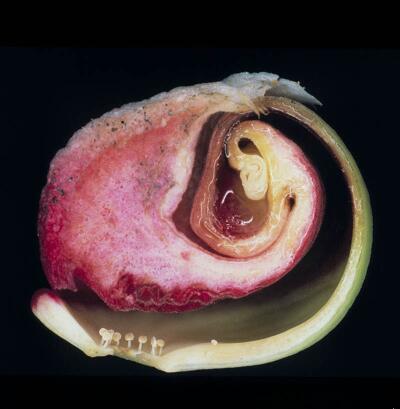Lecythidaceae
Couratari guianensis Aubl.

Kingdom: Plantae Rank: Species Parent: Couratari Status: Valid
Common Names:
- Machimango, machimango branco, ullu caspi (Peru) - Spanish, Peru
Taxonomic Classification
Classification: The juvenile leaves of this species are different from the adult leaves in texture (thinner) and pubescence (less pubescent). There is considerable variation in the size of fruit with the largest fruits coming from the Isla Coiba in Panama and from trees in French Guiana near Camp Inselberg of the Nouragues National Park. Fruit variation can be considerable even among fruits from the same tree (see Fig. 54 in Prance, 1990)
Morphological Description
Diagnosis: Leaves without longitudinal striations; flowers when leaves absent; petals and androecium with at least some tinges of red or pink; hood verrucose not echinate; fruits brown with white spotted lenticels.
Vegetative Morphology
Habit: Trees, to 50 m. Trunks buttressed.
Leaves: Leaves with petioles 13-25 mm long; blades 8-19 x 4-10 cm, oblong, obovate, or elliptic, with trichomes abaxially especially along the veins, without longitudinal lines parallel to midrib; domatia absent; base rounded to broadly subcuneate; margins entire; apex rounded, retuse, or shortly and broadly blunt-acuminate; secondary veins in 16-22 pairs, the secondary veins mostly percurrent, plan or impressed adaxially.
Stipules: Stipules absent, at least in adults.
Exudate: Exudate absent.
Reproductive Morphology
Inflorescence: Inflorescences terminal or axillary, racemes or sparsely branched panicles, the rachises pubescent; pedicels 10-20 mm long.
Flowers: Flowers when leafless, the flowers ca. 2-3 cm diam; hypathium pubescent; petals 5-6 times longer than wide, white tinged with pink to purple; androecial hood with verrucose but not echinate external flap, pink to purple.
Fruit: Fruits dehiscent, 12-17 x 6 cm, cylindrical, brown with numerous light colored spots (lenticels?) on the exterior.
Other
Uses: The wood is used in construction (Gazel, 1990). The fibrous inner bark can be used for caulking boats, cordage, and for making paper for cigars (Marín & Flores, 2005.
Distribution: Southwestern Costa Rica, Panama, northwestern Colombia, northeastern Venezuela, throughout the Guianas and Amazonian Bolivia, Brazil, Colombia, Ecuador, and Peru.
Ecology: Terra firme forests below 500 meters.
Chromosome Number: Unknown.
Notes: This species drops its leaves, flowers profusely for a relatively short period, and then flushes new leaves. At peak flowering, the entire tree is covered with flowers that appear pink or purple from a distance. There are no studies of the pollination biology of this species but the flower offers nectar as a reward and bees are most likely the pollinators. Other species of Couratari are known to be pollinated by bees. The winged seeds are dispersed by the wind.
Typification
Type Citation: Hist. Pl. Guiane 2: 724, t. 290. 1775, pro parte.
Basionym: Not applicable.
Basionym Citation: Not applicable.
Type Locality: French Guiana, without specific locality.
Type Collection: Aublet s.n.
Types Deposited at: Holotype: lectotype, BM, fruit only, not the leaves, designated Prance; Isotypes: None
Other Published Figures: Polak, A. M. 1992. Major timber trees of Guyana. A field Guide. Tropenbos Series 2: Pp. 76-77 – habit, fl, fr, seed & se